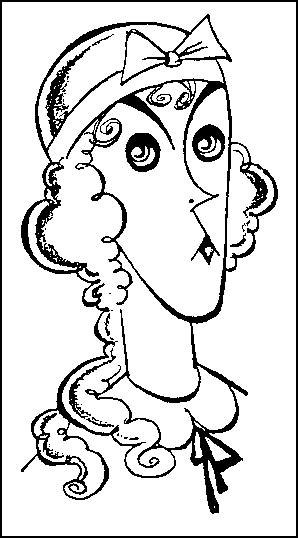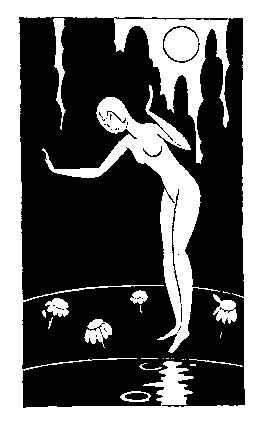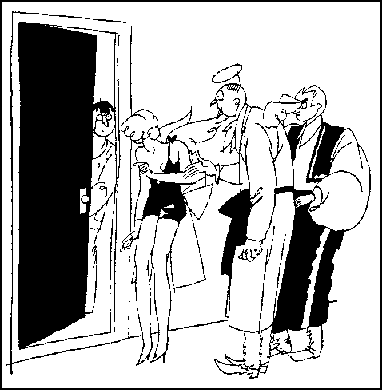Of the King:
The Story of My Life
Aimée Semple McPherson
(Boni & Liveright)
Isadora Duncan
(Boni & Liveright)
 These books prove anew what was long ago observed by sagacious men: that only a shadow separates angel from devil, devotée from damned. A trivial accident in youth might have turned La Duncan into a McPherson, and another might have saved La McPherson from the pulpit and set her loose upon the stage.
These books prove anew what was long ago observed by sagacious men: that only a shadow separates angel from devil, devotée from damned. A trivial accident in youth might have turned La Duncan into a McPherson, and another might have saved La McPherson from the pulpit and set her loose upon the stage.
Superficially, to be sure, they differ enormously. La Duncan (posthumously, alas!) devotes a large part of her volume to shameless bragging about her drabbing; La McPherson (still alive, glory to God!) devotes at least a third of hers to prove that she is chaste. But all that is only on the surface: deep down the two gals are tremendously alike. Both are mystics, and hear strange voices over the sky-rim. Both, disdaining money, come eventually to the lush, voluptuous material success of movie queens. And both have sad hearts, and reach out wistfully for something that never was on land or sea.
Once, detained in Los Angeles by literary business, I permitted one of Aimée's fans, a man named Brother Quirk, to lure me to her basilica, the Angelus Temple. Her sacerdotal smile was as wide as a bath-towel, but it took no more than ten or fifteen minutes for me to note that it was really only a smirk. Underneath it I detected a great sadness. The lady, indeed, was so tragic that she made me uncomfortable, hardened though I was to the grinning masks of Hollywood. I hope no one will accuse me of impertinence when I venture the guess that there was nothing she longed for more earnestly, on that melancholy Sunday afternoon, than a pair of strong male arms around her neck and the pillow of a heaving, piliferous chest. Not even the sudden conversion and baptism of Quirk himself would have done her more good.
 The Duncan book, I assume, was planned as the first of two volumes. It stops short with the fair (and, by that time, somewhat fat) author's invasion of Russia in 1921. That invasion turned out to be as ill-starred as Napoleon's, and she was presently back in France, where she was to die in 1927. What she has to say in her first volume about her curiously banal love affair has made the book a roaring success, and it is now being read by all the flappers who devoured The President's Daughter six months ago. But what gives it solid interest is not this pathetic and almost mannish mulling over cold amours, but the author's laborious and vain effort to explain the principles of her so-called Art.
The Duncan book, I assume, was planned as the first of two volumes. It stops short with the fair (and, by that time, somewhat fat) author's invasion of Russia in 1921. That invasion turned out to be as ill-starred as Napoleon's, and she was presently back in France, where she was to die in 1927. What she has to say in her first volume about her curiously banal love affair has made the book a roaring success, and it is now being read by all the flappers who devoured The President's Daughter six months ago. But what gives it solid interest is not this pathetic and almost mannish mulling over cold amours, but the author's laborious and vain effort to explain the principles of her so-called Art.
This effort leaves it revealed as precisely what it was: a mass of puerilities, without any more rational basis than golf or spiritualism. Isadora, simply loved to prance around in a shift; all the rest was afterthought. The daughter of a music teacher, she began this prancing very early in life and to the tune of relatively respectable music; in the fact lay the seed of her future success. It gave the world and especially the world of artists, pleasant shock to see the shift waving and billowing to the tunes of Chopin and Tschaikovsky; there was another shock later on when it began to flap to the tune of Wagner and Brahms. It was an era of painfully correct billet-dancing, and to worn-out tin-pan music. Here, at least, was something new --- and straightway it came converted into something portentous. But its meaning, at bottom, was exactly that of any other dancing, which is to say it had scarcely any meaning at all.
Isadora lived and died without anything properly describable as an education, but she was quick, womanlike, to take color from her surroundings, and so she picked up a great deal of profound prattle, and some of it she unloaded into her book. On analysis, it turns out to be very hollow. With one breath she connects her dancing with the figures on Greek urns, and with the, next she protests that it was completely American, and had Walt Whitman for its pa. At other times she talks darkly of Beethoven, Wagner and Nietzsche --- "the first dancing philosopher." But what had Nietzsche to do with her melodramatic performance of "The Marseillaise," and what had Wagner to do with her writhing to "The Beautiful Blue Danube" --- her two most solid successes?
The more she goes into this matter, in fact, the more absurd she becomes, Her tragedy was that she was not content to be a first-rate bare-legged dancer: she also yearned to be an intellectual. The same folly has engulfed many other ladies of the stage. It is responsible for the ghastly Ibsen revivals that drive dramatic critics to cocaine and heroin, and it is responsible too for the dreadful memoirs that their Heddas and Noras write.
Let it be said for La Duncan that her own tome, though it is full of buncombe, is nevertheless very interesting. In it, for the first time, a lady of many loves discusses them realistically, if at the same time somewhat gurglingly. It presents one fact hitherto unnoticed by science: that even a professional charmer sometimes finds it immensely difficult to snare her man. Isadora conquered a great many, but her flops were almost as numerous as her conquests. It was her ambition to bear children to men of eminence, and to that end (according to her own account) she tackled such whales of science as Ernst Haeckel and such sound artists as George Grey Barnard. But they were beyond her seductions, and so, of her actual offspring, two out of three were fathered by dismal nonentities. A foolish woman and a sad life.
 La McPherson has been used almost as badly by the Omnipotence she venerated. Her first husband was a missionary to China, and died miserably out there, leaving her with a small baby and no funds. Her second seems to have left her nearly as quickly, though under his own
steam: her souvenir was another infant.
La McPherson has been used almost as badly by the Omnipotence she venerated. Her first husband was a missionary to China, and died miserably out there, leaving her with a small baby and no funds. Her second seems to have left her nearly as quickly, though under his own
steam: her souvenir was another infant.
For years she toured the Bible Belt in a Ford, haranguing the morons nightly, under canvas. It was a depressing life, and its usufructs were scarcely more than three meals a day. Often, indeed, there was too little money to buy them, and she had to depend upon the charity of the pious. She was attracted to Los Angeles, it appears, by the climate. The Bible Belt was sending a steady stream of its rheumatic mortgage sharks in that direction, and she simply followed. The result, as everyone knows, was a swift and roaring success. The town has more morons in it than the whole State of Mississippi, and thousands of them had nothing to do save gape at the movie dignitaries and go to revivals.
Aimée piped a tune that struck their fancy and in a short while she was as massive a local figure as Sid Grauman or the Rev. Bob Shuler. In five years she had a plant almost as big as that of Henry Ford, with an auditorium seating 5300 customers, a huge Bible School, a radio broadcasting station, a flourishing publishing house, three brass bands, three choirs, two orchestras and six quartettes. She is today the most prosperous ecclesiastic in America and her annual net takings exceed those of Bishop Manning.
But, as I have said, I doubt that she is happy in the homely secular sense, though the grace of God is undoubtedly in her. I detect a far-away look in her eye, an I detect a heavy heart in her book, despite its smooth, glad air of a Y. M. C. A. secretary. Certainly the attempt to jail her on perjury, a year ago, left some scars on her.
Connoisseurs will recall the outlines of the case: she alleged that she had been kidnapped, and the Los Angeles police alleged that she had been on a protracted week-end party with one of her male employees. She won in the end, but only after a long and nerve-wracking trial, in the course of which she had plenty of chance to observe that Moronia could punish as well as applaud. The trial, indeed, was an orgy typical of the half-fabulous California courts. The very officers of justice denounced her riotously in the Hearst papers while it was in progress, and she says herself that she was almost asphyxiated by the smoke of photographers' flash-lights in the courtroom.
She rehearses the evidence in her book, and makes out a good case for herself. But she must know very well that Los Angeles will remember the testimony against her long after it forgets the testimony that cleared her. The morons of the town are not all Bible students. There are also hundreds of thousands whose ideas of the true, the good and the beautiful are derived from the movies and from Hearst.
The theology of La McPherson, as she expounds it in her book, is a poor thing, and not her own. Wherever the hookworm bays to its mate and a horsehair put into a bottle of water is known to turn into a snake, it is preached every night, and by thousands of sweating evangelists. Its four cornerstones are the Atonement, Baptism, Divine Healing, and the Second Coming.
"Good works and good morals of themselves are not sufficient:" the penitent must be "born again" --- and not only born again, but formally ducked in the Angelus Temple pool. To doubt that prayer can induce God to cure a broken leg today is to doubt the miracles recorded in Holy Writ --- obviously, a very serious matter. And "He who ascended into Heaven will some day come again in clouds of glory to catch away His own."
There is comfort here for poor and wormy folk. They swam in Los Angeles as they swarm nowhere else on earth. They come in from the farms and cow towns with their lumbago, their shortness of breath, their broken ribs, their ringing in the ears, their souvenirs of bad medicine, bad surgery, bad obstetrics, and Aimée cheers them up. In a little while they vanish into Heaven, but more are always on the way. If all the forlorn pilgrims she baptizes every year remained on her rolls, her Angelus Temple would swell to the proportions of a county, and shove Los Angeles into the Pacific. But they come and they go, each leaving a mite. The pastor no longer wonders where her next meal is coming from; it takes a great deal of exercise to keep her from growing matronly. But she is not only well-fed, she is also intelligent, and so I suspect that is by no means as happy as she tries to look.
From The American Mercury (1930)